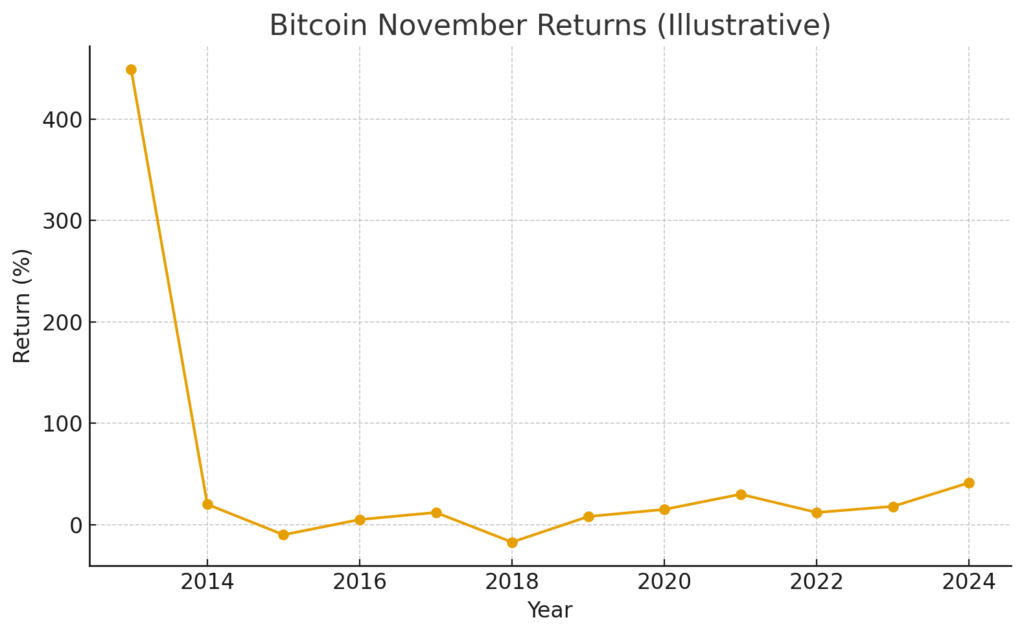
Key Takeaways :
- Bitcoin fell over 10% in seven days, briefly dropping below $90,000, challenging November’s historical reputation as its strongest month.
- Analysts emphasize that today’s macro conditions differ sharply from past cycles — including delayed U.S. economic data due to the federal government shutdown.
- November’s historically high average return (41.35%) is skewed heavily by 2013’s +449% surge, making comparisons misleading.
- Analysts see signs that BTC may be forming a local bottom, with stabilization emerging after one of the sharpest corrections of the current cycle.
- Key resistance for recovery lies between $97,000–$100,000; reclaiming this range is critical for renewed bullish momentum.
- Long-term investors seeking new crypto assets, yield opportunities, and practical blockchain applications should watch how Bitcoin’s behavior in late 2025 reshapes market sentiment.

Introduction — A November Unlike Any Other
November has historically been Bitcoin’s strongest month, delivering an average return of 41.35% since 2013. Traders have long viewed it as a seasonally favorable period, often driven by post-summer inflows, end-of-year positioning, and unique sentiment patterns in the digital asset market. However, November 2025 has deviated violently from this trend. Over the last seven days, Bitcoin has fallen more than 10%, briefly dipping below $90,000 before recovering to the $93,290 range.
Analysts warn that while historical averages look bullish on paper, the reality is far more complex. The macroeconomic landscape, regulatory conditions, and behavioral dynamics now differ drastically from prior years. As a result, Bitcoin’s “strongest month” narrative is facing its biggest challenge in a decade.
This article synthesizes insights from the referenced news report, adds context from recent market developments, and provides deeper analysis for readers seeking new investment opportunities, yield strategies, or practical blockchain use cases.
1. Why This November Is Different — The Macro Reset
A Distorted Historical Average
Bitcoin’s November performance average (41.35% since 2013) is misleading because it is disproportionately influenced by the 2013 bubble year, during which BTC soared +449% in a single month. Removing this outlier drops the average sharply and aligns the month closer to Bitcoin’s general historical volatility.
A Weak November in 2025
Bitcoin is currently down 15.37% month-to-date, on track to become the worst November since 2019, which closed at –17.27%.
The decline is not purely technical — macroeconomic turbulence plays a decisive role.
The U.S. Government Shutdown Ripple Effect
Analysts such as James Harris from Tesseract highlight that this year’s environment is uniquely distorted by the recent six-week U.S. government shutdown, which caused severe delays in economic data reporting.
When the government reopened, investors were hit with a sudden influx of delayed inflation metrics, employment data, and consumer indicators — all condensed into a short timeframe. This data flash forced traders to rapidly reassess their expectations for monetary policy.
Falling Expectations for Rate Cuts
The CME FedWatch Tool shows that the probability of a December Federal Reserve rate cut has fallen to 41%. Higher rates for longer translate to:
- stronger USD
- tighter global liquidity
- decreased appetite for risk assets
- downward pressure on BTC and tech-aligned markets
In short: November is no longer operating under the same macro assumptions that supported past bull cycles.
2. The Market Reaction — Sharp Declines and Psychological Stress
Bitcoin’s drop below $90,000 rattled retail sentiment and triggered a wave of forced liquidations. However, analysts point out that such deep corrections are not only expected in bull markets — they are structurally necessary.
Short-Term Holders Under Stress
Bitfinex analysts emphasize that sustainable bottoms historically form only after short-term holders capitulate at a loss. This appears to be underway now, with on-chain data showing:
- rising realized losses
- decreasing short-term cost basis
- reduced speculative inflow
The market may therefore be approaching its local bottom, even if full recovery remains uncertain.
3. Signs of Stabilization — The Early Formation of a Local Bottom
Bottoming Behaviors Align With Past Cycles
Bitfinex notes that the current correction is among the sharpest of this cycle, rivaling drawdowns during earlier stages of the bull market. Yet despite this, they identify stabilizing signals:
- selling pressure is diminishing
- long-term holders remain unmoved
- exchange inflows are decreasing
- derivatives open interest is resetting
These factors suggest the market may be transitioning from disorder to equilibrium.
Why Recoveries Can Be Violent
Crypto payments firm B2BinPay explains that once bottom formation completes:
“Sustained recovery can form rapidly.”
Bitcoin’s liquidity structure often results in thin order books, meaning that once bearish pressure exhausts, upward moves can accelerate dramatically.
4. Key Levels to Watch — Resistance at $97,000–$100,000
The most important short-term range is $97,000–$100,000.
Why This Range Matters
- It served as major support before the breakdown.
- It contains high-volume nodes from the October rally.
- It overlaps with options open interest clusters.
- Breaking back above it would restore bullish confidence.
As long as BTC stays below $97,000, investor psychology remains defensive.
Path Toward Reclaiming the All-Time High
Bitcoin’s current all-time high of $125,100 reached in early October remains technically possible before year-end, though analysts caution that it is not their base prediction.
A late December rally is more plausible than a November surge, given the macro reset and ongoing market unwinding.
5. Implications for Investors Seeking New Crypto Opportunities
For readers aiming to discover new assets, yield strategies, or practical blockchain opportunities, Bitcoin’s November volatility provides key insights:
A. New Crypto Assets
When Bitcoin weakens sharply, capital rotation often increases toward:
- mid-cap L1/L2 ecosystems
- high-utility tokens
- yield-bearing DeFi assets
- RWA-linked stablecoins
Periods of BTC consolidation historically seed the next wave of altcoin outperformance.
B. Yield Opportunities
Volatile markets create openings in:
- basis trading
- delta-neutral yield strategies
- exchange funding rate arbitrage
- Treasury-backed RWA yield aggregators
As funding rates reset during corrections, opportunities become more attractive.
C. Practical Blockchain Use Cases
Trends investors should monitor:
- On-chain settlement rails for cross-border commerce
- Stablecoin treasury management for corporations
- Tokenized money-market instruments
- Decentralized identity (DID) linked to compliance
These areas continue to attract institutional investment regardless of BTC volatility.
Conclusion — The End of the “Strongest Month” Myth?
Bitcoin’s November correction is not a breakdown of fundamentals but a reminder that historical averages cannot be blindly trusted — especially when distorted by rare outlier events. The macro environment has changed dramatically, and markets are recalibrating around new expectations for interest rates, liquidity, and geopolitical risk.
Yet the presence of stabilizing signals, bottom-formation indicators, and decreasing selling pressure suggests that Bitcoin may be entering a consolidation phase that often precedes powerful recoveries.
For investors seeking new crypto assets, yield opportunities, or real-world blockchain applications, this period of uncertainty should be viewed not as a threat, but as a preparation phase for the next major cycle.

